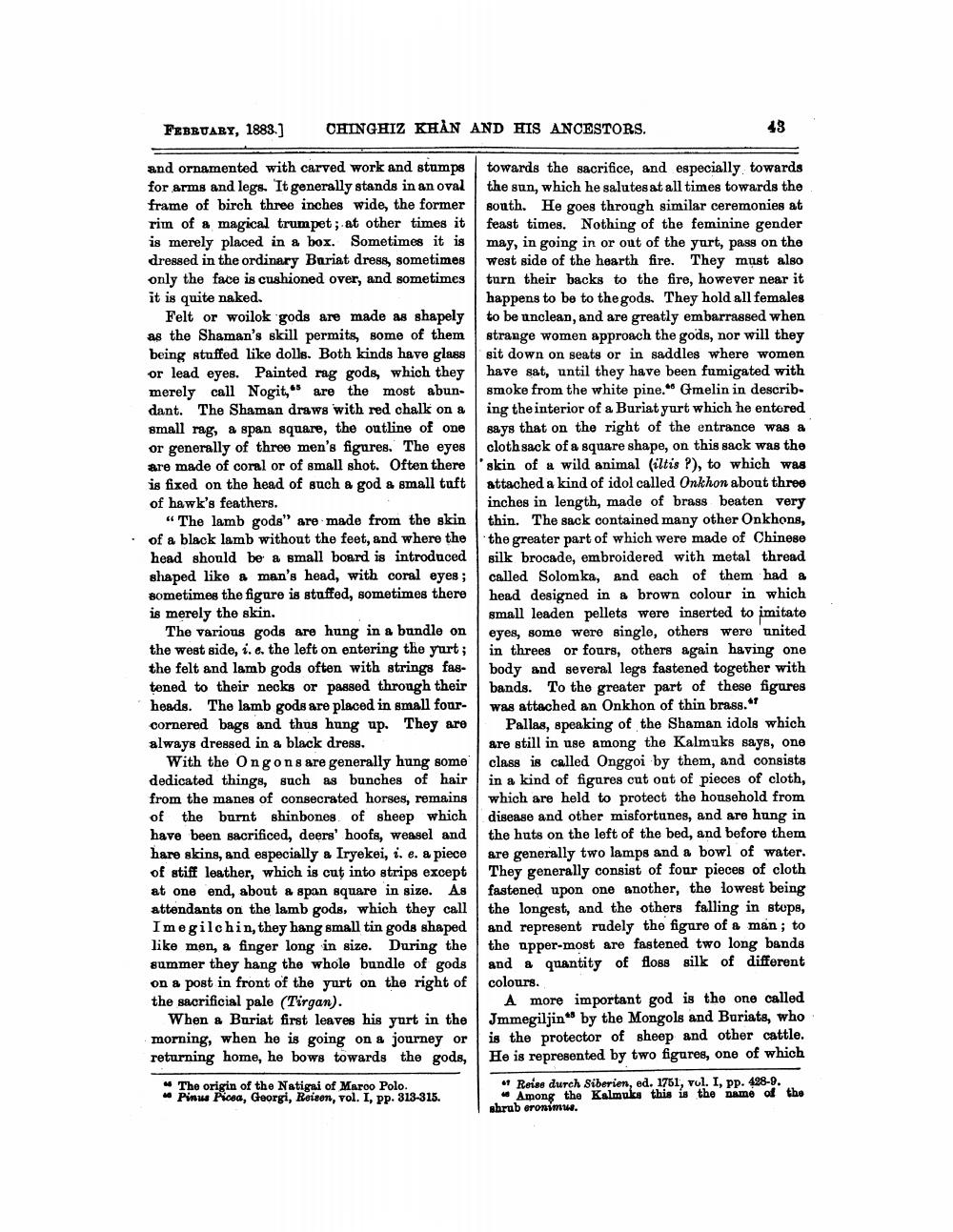________________
FEBRUARY, 1883.)
CHINGHIZ KHÅN AND HIS ANCESTORS.
and ornamented with carved work and stumps towards the sacrifice, and especially towards for arms and legs. It generally stands in an oval the sun, which he salutes at all times towards the frame of birch three inches wide, the former south. He goes through similar ceremonies at rim of a magical trumpet; at other times it feast times. Nothing of the feminine gender is merely placed in a box. Sometimes it is may, in going in or out of the yurt, pass on the dressed in the ordinary Bariat dress, sometimes west side of the hearth fire. They must also only the face is cushioned over, and sometimes turn their backs to the fire, however near it it is quite naked.
happens to be to the gods. They hold all females Felt or woilok gods are made as shapely to be unclean, and are greatly embarrassed when as the Shaman's skill permits, some of them strange women approach the gods, nor will they being stuffed like dolls. Both kinds have glass sit down on seats or in saddles where women or lead eyes. Painted rag gods, which they have sat, until they have been fumigated with merely call Nogit," are the most abun- smoke from the white pine. Gmelin in describdant. The Shaman draws with red chalk on a | ing the interior of a Buriat yurt which he entered small rag, a span square, the outline of one says that on the right of the entrance was a or generally of three men's figures. The eyes cloth sack of a square shape, on this sack was the are made of coral or of small shot. Often there ' skin of a wild animal (iltis ?), to which was is fixed on the head of such a god a small tuft attached a kind of idol called Onkhon about three of hawk's feathers.
inches in length, made of brass beaten very “The lamb gods" are made from the skin thin. The sack contained many other Onkhons, of a black lamb without the feet, and where the the greater part of which were made of Chinese head should be a small board is introduced silk brocade, embroidered with metal thread shaped like & man's head, with coral eyes; called Solomka, and each of them had a sometimes the figure is stuffed, sometimes there head designed in a brown colour in which is merely the skin.
small leaden pellets were inserted to imitate The various gods are hung in a bundle on eyes, some were single, others were 'united the west side, i.e. the left on entering the yurt; in threes or fours, others again having one the felt and lamb gods often with strings fas- body and several legs fastened together with tened to their necks or passed through their bands. To the greater part of these figures heads. The lamb gods are placed in small four- was attached an Onkhon of thin brass." cornered bags and thus hung up. They are Pallas, speaking of the Shaman idols which always dressed in a black dress.
are still in use among the Kalmuks says, one With the Ongons are generally hung some class is called Onggoi by them, and consists dedicated things, such as bunches of hair in a kind of figures cut out of pieces of cloth, from the manes of consecrated horses, remains which are held to protect the household from of the burnt shinbones of sheep which disease and other misfortunes, and are hung in have been sacrificed, deers' hoofs, weasel and the huts on the left of the bed, and before them hare skins, and especially a Iryekei, i.e. a piece are generally two lamps and a bowl of water. of stiff leather, which is cut into strips except They generally consist of four pieces of cloth at one end, about a span square in size. As fastened upon one another, the lowest being attendants on the lamb gods, which they call the longest, and the others falling in stops, Imegilchin, they hang small tin gods shaped and represent rudely the figure of a man; to like men, a finger long in size. During the the apper-most are fastened two long bands summer they hang the whole bundle of gods and a quantity of floss silk of different on a post in front of the yurt on the right of colours. the sacrificial pale (Tirgan).
A more important god is the one called When & Buriat first leaves his yurt in the Jmmegiljin" by the Mongols and Buriate, who morning, when he is going on a journey or is the protector of sheep and other cattle. returning home, he bows towards the gods, He is represented by two figures, one of which
The origin of the Natigai of Marco Polo. - Pinus Picea, Georgi, Reison, vol. I, pp. 313-315.
" Reise durch Siberien, ed. 1751, vol. I, pp. 428-9.
Among the Kalmuks this is the name of the shrub eronimus.




